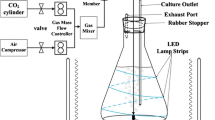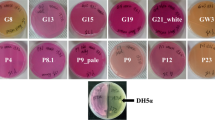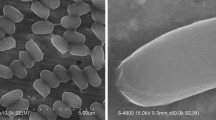Abstract
The cyanobacterium Pseudanabaena sp. FACHB 1277, a 2-methylisoborneol (2-MIB) producer isolated from Xionghe Reservoir, was identified by molecular biological methods based on the 16S rDNA sequence. Pseudanabaena sp. FACHB 1277 is a planktonic freshwater species with relatively high 2-MIB per cell density value (7.76 × 10−6 ng cell−1) and specific growth rate (0.25 ± 0.01 d−1). The effects of temperature and light intensity on 2-MIB production of Pseudanabaena sp. FACHB 1277 were investigated. Of the six temperatures tested, 10, 15, 20, 25, 30, and 35 °C, the maximum total 2-MIB per cell density and minimum cell density were observed at 10 °C, while the total 2-MIB and dissolved 2-MIB (including extracellular and dissolved intracellular 2-MIB) increased with increasing temperature. Among the six tested light intensities (10, 25, 40, 55, 70, and 85 μmol photons m−2 s−1), the minimum total 2-MIB per cell density and maximum cell density were observed at 25 μmol photons m−2 s−1. The total 2-MIB and extracellular 2-MIB increased with light intensity increasing from 10 to 40 μmol photons m−2 s−1, while no significant increase was observed when the light intensity was higher than 40 μmol photons m−2 s−1. The maximum intracellular 2-MIB (including dissolved and bound) occurred at 25 μmol photons m−2 s−1. The present study indicates that increasing temperature could favor the conversion of bound intracellular to dissolved 2-MIB, while increasing light intensity stimulates the release of dissolved intracellular 2-MIB into the environment.




Similar content being viewed by others

References
Acinas SG, Haverkamp THA, Huisman J, Stal LJ (2009) Phenotypic and genetic diversification of Pseudanabaena spp. (cyanobacteria). ISME J 3:31–46
Baker PD, Cunliffe DA, Graham DK (1994) Biological sources of taste and odour in the Millbrook-Mannum water supply system. Australian Centre for Water Treatment and Water Quality Research, Salisbury
Beltran EC, Neilan BA (2000) Geographical segregation of the neurotoxin-producing cyanobacterium Anabaena circinalis. Appl Environ Microbiol 66:4468–4474
Bentley R, Meganathan R (1982) Geosmin and methylisoborneol biosynthesis in Streptomycetes. FEBS Lett 125:220–222
Blevins WT, Schrader KK, Saadoun I (1995) Comparative physiology of geosmin production by Streptomyces halstedii and Anabaena sp. Water Sci Technol 31:127–133
Bowmer KH, Padovan A, Oliver RL, Korth W, Garf GG (1992) Physiology of geosmin production by Anabaena circinalis isolated from the Murrumbidgee River, Australia. Water Sci Technol 25:259–267
Castenholz RW, Rippka R, Herdman M, Wilmotte A (2001) Form-genus XII. Pseudanabaena Lauterborn 1916. In: Boone DR, Castenholz RW (eds) Bergey’s manual of systematic bacteriology, 2nd edn. Springer, Heidelberg, pp 554–557
Dickschat JS, Nawrath T, Thiel V, Kunze B, Müller R, Schulz S (2007) Biosynthesis of the off-flavor 2-methylisoborneol by the myxobacterium Nannocystis exedens. Angew Chem Int Ed 46:8287–8290
Fravel DR, Connick WJ, Grimm CC, Lloyd SW (2002) Volatile compounds emitted by sclerotia of Sclerotinia minor, Sclerotinia sclerotiorum, and Sclerotium rolfsii. J Agric Food Chem 50:3761–3764
Gerber NN (1969) A volatile metabolite of actinomycetes, 2-methylisoborneol. J Antibiot 22:508–509
Giglio S, Saint CP, Monis PT (2011) Expression of the geosmin synthase gene in the cyanobacterium Anabaena circinalis AWQC318. J Phycol 47:1338–1343
Gugger M, Lyra C, Henriksen P, Coute A, Humbert JF, Sivonen K (2002) Phylogenetic comparison of the cyanobacterial genera Anabaena and Aphanizomenon. Int J Syst Evol Microbiol 52:1867–1880
Ishida T, Watanabe MM, Sugiyama J, Yokota A (2001) Evidence for polyphyletic origin of the members of the orders of Oscillatoriales and Pleurocapsales as determined by 16S rDNA analysis. FEMS Microbiol Lett 201:79–82
Izaguirre G, Taylor WD (1995) Geosmin and 2-methylisoborneol production in a major aqueduct system. Water Sci Technol 31:41–48
Izaguirre G, Taylor WD (1998) A Pseudanabaena species from Castaic Lake, California, that produces 2-methylisoborneol. Water Res 32:1673–1677
Izaguirre G, Taylor WD (2004) A guide to geosmin- and MIB-producing cyanobacteria in the United States. Water Sci Technol 49:19–24
Izaguirre G, Hwang CJ, Krasner SW (1984) Investigations into the source of 2-methylisoborneol in Lake Perris, California. Proc 11th Ann Water Qual Technol Conf (Dec. 4–7, 1983, Norfolk, Va., USA). American Water Works Association, Denver, Colo., USA.
Izaguirre G, Taylor WD, Pasek J (1999) Off-flavor problems in two reservoirs, associated with planktonic Pseudanabaena species. Water Sci Technol 40:85–90
Jiang J, He X, Cane DE (2007) Biosynthesis of the earthy odorant geosmin by a bifunctional Streptomyces coelicolor enzyme. Nat Chem Biol 3:711–715
Jüttner F, Watson SB (2007) Biochemical and ecological control of geosmin and 2-methylisoborneol in source waters. Appl Environ Microbiol 73:4395–4406
Kajino M, Sakamoto K (1995) The relationship between musty-odor-causing organisms and water quality in Lake Biwa. Water Sci Technol 31:153–158
Kakimoto M, Ishikawa T, Miyagi A, Saito K, Miyazaki M, Asaeda T, Yamaguchi M, Uchimiya H, Kawai-Yamada M (2014) Culture temperature affects gene expression and metabolic pathways in the 2-methylisoborneol-producing cyanobacterium Pseudanabeana galeata. J Plant Physiol 171:292–300
Komárek J (2003) Planktic oscillatorialean cyanoprokaryotes (short review according to combined phenotype and molecular aspects). Hydrobiologia 502:367–382
Lauderdale CV, Aldrich HC, Lindner AS (2004) Isolation and characterization of a bacterium capable of removing taste- and odor-causing 2-methylisoborneol from water. Water Res 38:4135–4142
Li L, Song LR, Gan NQ, Chen W (2005) Determination of odorous compounds in water using headspace solid-phase microextraction-gas chromatography-mass spectrometry. Chinese J Anall Chem 33(8):1058–1062
Li L, Wan N, Gan NQ, Xiao BD, Song LR (2007) Annual dynamics and origins of the odorous compounds in the pilot experimental area of Lake Dianchi, China. Wat Sci Technol 55(5):43–50
Loza V, Perona E, Mateo P, Carmona J (2013) Phenotypic and genotypic characteristics of Phormidium-like cyanobacteria inhabiting microbial mats are correlated with the trophic status of running waters. Eur J Phycol 48:235–252
Marin B, Nowack EC, Glöckner G, Melkonian M (2007) The ancestor of the Paulinella chromatophore obtained a carboxysomal operon by horizontal gene transfer from a Nitrococcus-like gamma-proteobacterium. BMC Evol Biol 7:85
Martin JF, Izaguirre G, Waterstrat P (1991) A planktonic Oscillatoria species from Mississippi catfish ponds that produces the off-flavor compound 2-methylisoborneol. Water Res 25:1447–1451
Naes H, Post AF (1988) Transient states of geosmin, pigments, carbohydrates and proteins in continuous cultures of Oscillatoria brevis induced by changes in nitrogen supply. Arch Microbiol 150:333–337
Naes H, Utkilen HC, Post AF (1988) Factors influencing geosmin production in the cyanobacterium Oscillatoria brevis. Water Sci Technol 20:125–131
Negoro T, Ando M, Ichikawa N (1988) Blue-green algae in Lake Biwa which produce earthy-musty odors. Water Sci Technol 20:117–123
Newcombe G, Morrison J, Hepplewhite C (2002) Simultaneous adsorption of MIB and NOM onto activated carbon, I Characterisation of the system and NOM adsorption. Carbon 40:2135–2146
Nichols HW (1980) Growth media–freshwater. In: Stein JR (ed) Handbook of phycological methods: culture methods and growth measurements. Cambridge University Press, Cambridge, pp 8–24
Parsons TR (1980) Coulter counter for phytoplankton. In: Stein JR (ed) Handbook of phycological methods: culture methods and growth measurements. Cambridge University Press, Cambridge, pp 345–358
Saadoun IMK, Schrader KK, Blevins WT (2001) Environmental and nutritional factors affecting geosmin synthesis by Anabaena sp. Water Res 35:1209–1218
Schrader KK, Dennis ME (2005) Cyanobacteria and earthy/musty compounds found in commercial catfish (Ictalurus punctatus) ponds in the Mississippi Delta and Mississippi-Alabama Blackland Prairie. Water Res 39:2807–2814
Sugiura N, Iwami N, Inamori Y, Nishimura O, Sudo R (1998) Significance of attached cyanobacteria relevant to the occurrence of musty odor in Lake Kasumigaura. Water Res 32:3549–3554
Tabachek JL, Yurkowski M (1976) Isolation and identification of blue green algae producing muddy odor metabolites, geosmin, and 2-methylisoborneol, in saline lakes in Manitoba. J Fish Res Board Can 33:25–35
Taylor WD, Losee RF, Torobin M, Izaguirre G, Sass D, Khiari D, Atasi K (2006) Early warning and management of surface water taste-and-odor events. American Water Works Association Research Foundation, Denver
Thomazeau S, Houdan-Fourmont A, Coute A, Duval C, Couloux A, Rousseau F, Bernard C (2010) The contribution of sub-Saharan African strains to the phylogeny of cyanobacteria: focusing on the Nostocaceae family (Nostocales, Cyanobacteria). J Phycol 46:564–579
Tucker CS (2000) Off-flavor problems in aquaculture. Rev Fish Sci 8:45–88
Turner S, Pryer KM, Miao VP, Palmer JD (1999) Investigating deep phylogenetic relationships among cyanobacteria and plastids by small subunit rRNA sequence analysis. J Eukaryot Microbiol 46:327–338
Vilalta E, Guasch H, Muñoz I, Romaní A, Valero F, Rodriguez JJ, Alcaraz R, Sabater S (2004) Nuisance odours produced by benthic cyanobacteria in a Mediterranean river. Water Sci Technol 49:25–31
Wang Z, Li R (2015) Effects of light and temperature on the odor production of 2-methylisoborneol-producing Pseudanabaena sp. and geosmin-producing Anabaena ucrainica (cyanobacteria). Biochem Syst Ecol 58:219–226
Watson SB (2004) Aquatic taste and odor: a primary signal of drinking-water integrity. J Toxicol Environ Health A 67:1779–1795
Welch RA, Burland V, Plunkett G III, Redford P, Roesch P, Rasko D, Buckles EL, Liou SR, Boutin A, Hackett J, Stroud D, Mayhew GF, Rose DJ, Zhou S, Schwartz DC, Perna NT, Mobley HL, Donnenberg MS, Blattner FR (2002) Extensive mosaic structure revealed by the complete genome sequence of uropathogenic Escherichia coli. Proc Natl Acad Sci U S A 99:17020–17024
Wert EC, Korak JA, Trenholm RA, Rosario-Ortiz FL (2014) Effect of oxidant exposure on the release of intracellular microcystin, MIB, and geosmin from three cyanobacteria species. Water Res 52:251–259
Wu JT, Jüttner F (1988) Effect of environmental factors on geosmin production by Fischerella muscicola. Water Sci Technol 20:143–148
Yagi M, Kajino M, Matsuo U, Ashitani K, Kita T, Nakamura T (1983) Odour problems in Lake Biwa. Water Sci Technol 15:311–321
Yeh K, Chang J, Chen W (2010) Effect of light supply and carbon source on cell growth and cellular composition of a newly isolated microalga Chlorella vulgaris ESP-31. Eng Life Sci 10:201–208
Young WF, Horth H, Crane R, Ogden T, Arnott M (1996) Taste and odor threshold concentrations of potential potable water contaminants. Water Res 30:331–340
Zhang T (2008) Ecological Investigation and physiological characteristics of earthy-musty odor-producing cyanobacteria. Dissertation, Institute of Hydrobiology, the Chinese Academy of Science, pp. 8–13.
Zhang T, Li L, Song LR, Chen W (2009) Effects of temperature and light on the growth and geosmin production of Lyngbya kuetzingii (Cyanophyta). J Appl Phycol 21:279–285
Zhang T, Li L, Zuo YX, Zhou Q, Song LR (2010) Biological origins and annual variations of earthy-musty off-flavours in the Xionghe Reservoir in China. J Water Supply Res Technol 59:243–254
Zhang T, Li D, Li J (2012) Biosynthesis of geosmin and 2-methylisoborneol in the prokaryotes—a review. Acta Microbiol Sin 52:152–159
Zimba PV, Dionigi CP, Millie DF (1999) Evaluating the relationship between photopigments and secondary metabolite accumulation in cyanobacteria. J Phycol 35:1422–1429
Acknowledgments
This study was supported by the National Natural Science Foundation of China-Israel Science Foundation (Grant No. 41561144008) and the National Natural Science Foundation of China (Grant No. 31000183).
Author information
Authors and Affiliations
Corresponding authors
Electronic supplementary material
Below is the link to the electronic supplementary material.
Fig. S1
(DOCX 43 kb)
Rights and permissions
About this article
Cite this article
Zhang, T., Zheng, L., Li, L. et al. 2-Methylisoborneol production characteristics of Pseudanabaena sp. FACHB 1277 isolated from Xionghe Reservoir, China. J Appl Phycol 28, 3353–3362 (2016). https://doi.org/10.1007/s10811-016-0864-x
Received:
Revised:
Accepted:
Published:
Issue Date:
DOI: https://doi.org/10.1007/s10811-016-0864-x



